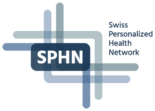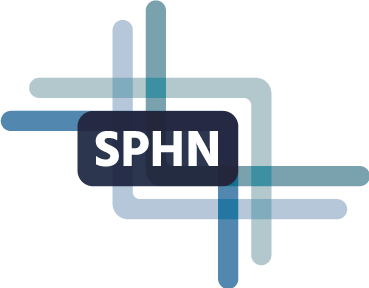Radiomics for comprehensive patient and disease phenotyping in personalized health (IMAGINE)
Main PI: Prof. Matthias Guckenberger (USZ)
Project consortium: Prof. Mauricio Reyes (UniBE), Dr. Bram Stieltjes (USB), Prof. Roland Wiest (UniBE), Prof. Christoph Stippich (USZ), Prof. Reto Meuli (CHUV), Prof. Stephanie Tanadini-Lang (USZ), Prof. Nicolaus Andratschke (USZ), Prof. Adrien Depeursinge (HES-SO Valais), Prof. Olivier Michielin (HUG), Prof. Giorgio Treglia (EOC)
Project coordinator: Prof. Stephanie Tanadini-Lang (USZ
Main achievements
In this SPHN Driver project, we built a Swiss-wide infrastructure for image-based biomarker research and analysis. We standardized MR image acquisition, image analysis and image-based outcome modelling to evaluate the value of MR images acquired in clinical routine as prognostic and predictive biomarker in patients treated for Glioblastoma multiforme.
- The ethical, legal and governance framework has been set with several document templates available for reuse.
- The involved sites harmonized the MR-image acquisition protocol for Glioblastoma brain cancer and developed a consensus protocol for MRI sequence standardization. The protocols are now implemented in several institutions for routine patient care. Further, a phantom-based image quality control of MRI scanners was implemented. Involved centers are able to upload phantom data to a web interface and to get a quality report. This ensures robustness in MR image reconstruction and image analyses methodologies. This important step will facilitate further quantitative imaging studies for Glioblastoma cancer patients.
- We developed local pipelines for MR image extraction and clinical data retrieval at the hospitals and established connectivity to the centralized SPHN computing and storage infrastructure. The standardization of anonymization of MR images was conducted together with the swiss-wide SPHN working group. A fully curated dataset of 748 patients with MR images before treatment and basic clinical variables are available on Leonhard Med, a BioMed IT node of SPHN.
- Additionally we were able to establish quantitative analysis of multi-sequence MR images as complementary biomarker to multidimensional outcome modelling in personalized treatment of the most frequent and malignant brain tumor. For the segmentation of normal and pathological structures, which is essential for extracting radiomics features, a dedicated software (BraTumIA) was developed. Further, a platform for radiomics calculation (QuantImage) was built, which allows the calculation of thousands of quantitative image features, which comprehensively characterize medical images or specific sub-volumes.
Reusable infrastructure and datasets
Standardized protocol and phantom-based quality assurance for MR image acquisition
We have established a standardized MR image acquisition protocol as well as a standardized quality assurance for Glioblastoma patients to improve overall scanner performance to reduce the variation in quantitative radiomics parameters origination from poor scanner calibration.
- Consensus for standardized MR image acquisition protocol
- A web interface to enable each hospital to upload MR phantom data and download a quality report which is used regarding MR image quality assurance
Available resources
White paper in preparation for a larger endorsement of the consensus protocol
Standardized dataset specifications for data curation at hospitals and delivery to Biomed-IT nodes
- Connection of adequate source systems to clinical data warehouses (CDW) at hospitals; enriched with clinical data needed for the IMAGINE project, including general patient information but also parameters as diagnosis, systemic therapies, radiotherapies, surgeries, genetic mutations
- Software for project-specific data extraction from CDW at the hospitals
- Image extraction software to gather the selected DICOM from the PACS system
- Harmonized anonymization protocol for DICOM MR-images
- De-identification tools for medical images and clinical data with linkage between images and clinical variables
- Software to model clinical data into a standardized data format (RDF)
- SPHN – IMAGINE – RDF – ontology: mapping of project-specific clinical variables into RDF
- Implemented transfer tools to send the data to Leonhard Med (a secure isolated tenant; BiomedIT node in Zurich)
Available resources
Please contact the IT departments of the involved hospitals or the local PIs.
Dataset for glioblastoma patients
Within our project, we have curated one of the world’s biggest dataset for Glioblastoma patients, consisting of 748 patients, for which MR brain imaging and clinical data are available.
All participating hospitals have delivered data for patients diseased with glioblastoma which were diagnosed between January 2004 and July 2021 and aged between 18 and 100 at diagnosis.
For each patient, brain MR images before treatment in DICOM format as well as a set of minimal clinical data according to the RDF Imaging Ontology were delivered through the BiomedIT-nodes to Leonhard Med. The clinical variables included demographic, diagnosis- and treatment-related information required for predictive modeling.
During our data curation pipeline on Leonhard Med, delivered data were checked and prepared for modeling. A dataset consisting of 1030 patients with MR studies acquired before first treatment and information on their overall survival, MGMT promoter methylation status and more was curated on Leonhard Med.
For our image processing pipeline, the MR studies were checked on their sequences. Only studies containing all four different sequence types T1, T1 contrast, T2 and Flair sequences, could be selected for further processing. The DICOM images were converted to nifti, the tumor region segmented with DeepBraTumIA and then, radiomics features were extracted. Overall, a final dataset of 748 patients with acceptable or good quality images was selected.
For all these patients, a curated clinical dataset is available with information on diagnosis date, age at diagnosis, gender, MGMT promoter methylation status, IDH mutation, overall survival, start of first radiotherapy, first treatment-related surgery and systemic therapy.
Available resources
The dataset is securely stored at the IMAGINE project space at Leonhard Med in Zurich and the project group is planning on making the data open access.
This is still work in progress together with the data governance boards of the respective hospitals and SPHN.
Please contact Stephanie Tanadini-Lang for access and specific requirements.
Image segmentation and data analysis (radiomics)
- Software solution for automated brain tumor segmentation: DeepBraTumIA
- Standardized radiomics biomarkers (image biomarker standardization initiative: IBSI)
- Radiomics platform: an online tool for radiomics analysis and model building: QuantImage v2
Available resources
Data dictionaries
MR images were delivered in DICOM format, which is an international standard for medical images. The DICOM tags were de-identified according the guidelines which were defined by the Swiss wide working group on DICOM de-identification and which are aligned with international standards.
The RDF (Resource Description Framework) is used as format to share the clinical dataset. The SPHN ontology is defined in an RDF schema that indicates the concepts and rules to follow for generating a structured knowledge graph of the clinical datasets.
The IMAGINE variables were evaluated for RDF modelling and unmapped information was discussed and shared with DCC and integrated into the SPHN ontology.
Follow up projects – continuation – next steps
We aim to make the collected data open access. This is still work in progress together with the data governance boards of the respective hospitals and SPHN.
Whereas the Driver project IMAGINE was restricted to MR imaging, we aim in a next step to generalize the radiomics methodology and infrastructure by expanding to multimodality imaging (CT and MRI imaging), to longitudinally acquired imaging, and to prospectively collected data. Further, this will be achieved by the implementation of a novel automatic methodology for the identification of MR image sequences and by the identification of new imaging biomarkers. As done for IMAGINE, our methods for extracting, anonymizing and analyzing images will pave the way for other groups, enabling them to collect and analyze radiological images in a standardized, efficient and automated manner.
Links and references
Github: https://git.dcc.sib.swiss/hospital-it/project-imagine
Watch the SPHN Webinar
References on Pubmed
- You, Suhang, Roland Wiest, and Mauricio Reyes. "SaRF: Saliency regularized feature learning improves MRI sequence classification." Computer methods and programs in biomedicine 243 (2024): 107867.
- You, Suhang, et al. "Sagtta: saliency guided test time augmentation for medical image segmentation across vendor domain shift." 2023 IEEE 20th International Symposium on Biomedical Imaging (ISBI). IEEE, 2023.
- You, Suhang, and Mauricio Reyes. "Influence of contrast and texture based image modifications on the performance and attention shift of U-Net models for brain tissue segmentation." Frontiers in Neuroimaging 1 (2022): 1012639.
- Vincent Andrearczyk, Julien Fageot, Valentin Oreiller, Xavier Montet and Adrien Depeursinge, Local Rotation Invariance in 3D CNNs (2020), in: Medical Image Analysis, 65(101756)
- Valentin Oreiller, Vincent Andrearczyk, Julien Fageot, John O. Prior and Adrien Depeursinge, 3D Solid Spherical Bispectrum CNNs for Biomedical Texture Analysis, arXiv:2004.13371v2, 2020
- Adrien Depeursinge, Vincent Andrearczyk, Philip Whybra, Joost van Griethuysen, Henning Müller, Roger Schaer, Martin Vallières and Alex Zwanenburg, Standardised convolutional filtering for radiomics, arXiv:2006.05470v2, 2020
- Crimi A., Bakas S. (eds) Brainlesion: Glioma, Multiple Sclerosis, Stroke and Traumatic Brain Injuries. BrainLes 2020. Lecture Notes in Computer Science, vol 12658. Springer, Cham. https://doi.org/10.1007/978-3-030-72084-1_36
- Alex Vils, Marta Bogowicz, Stephanie Tanadini-Lang, Diem Vuong, Natalia Saltybaeva, Johannes Kraft, Hans-Georg Wirsching, Dorothee Gramatzki, Wolfgang Wick, Elisabeth Rushing, Guido Reifenberger, Matthias Guckenberger, Michael Weller, Nicolaus Andratschke. Radiomic analysis to predict outcome in recurrent glioblastoma based on multi-center MR imaging from the prospective DIRECTOR trial. Frontiers in Oncology, in-press
- Jungo, A., Balsiger, F. and Reyes, M., 2020. Analyzing the quality and challenges of uncertainty estimations for brain tumor segmentation. Frontiers in neuroscience, 14, p.282.
- de Mello, J.P.V., Paixão, T.M., Berriel, R., Reyes, M., Badue, C., De Souza, A.F. and Oliveira-Santos, T., 2021, January. Deep Learning-based Type Identification of Volumetric MRI Sequences. In 2020 25th International Conference on Pattern Recognition (ICPR) (pp. 1-8).
- Aly H. Abayazeed, Mohamed K. Abdelmohsen, Michael Hill, Michael Mueller, Mohamed Qayati, Shady Mohamed, Mahmoud Mekhemer, Ahmed Abbassy, Mauricio Reyes. Clinical Translation: Development And Performance Testing Of A Generalizable And Reproducible High-Grade Glioma MRI Segmentation And Volumetric Analysis Deep-Learning Network For Longitudinal Assessment To Clinically Inform The Modified Response Assessment In Neuro-Oncology Criteria. MICCAI-CLINICCAI, 2021.
- Roger Schaer, Valentin Oreiller, Daniel Abler, Himanshu Verma, Julien Reichenbach, Florian Evéquoz, Mario Jreige, John O. Prior and Adrien Depeursinge, QuantImage v2: A Clinician-in-the-loop Cloud Platform for Radiomics Research, in: European Society of Radiology, 2022
- La Greca Saint-Esteven, A., Vuong, D., Tschanz, F., van Timmeren, J. E., Dal Bello, R., Waller, V., ... & Tanadini-Lang, S. (2021). Systematic review on the association of radiomics with tumor biological endpoints. Cancers, 13(12), 3015.
- Saltybaeva, Natalia, et al. "Robustness of radiomic features in magnetic resonance imaging for patients with glioblastoma: Multi-center study." Physics and imaging in radiation oncology 22 (2022): 131-136.
- Daniel Abler, Roger Schaer, Valentin Oreiller, Himanshu Verma, Julien Reichenbach, Orfeas Aidonopoulos, Florian Evéquoz, Mario Jreige, John O. Prior and Adrien Depeursinge, QuantImage v2: A Comprehensive and Integrated Physician-Centered Cloud Platform for Radiomics and Machine Learning Research (2023), in: European Radiology Experimental, 7:16
- Himanshu Verma, Jakub Mlynar, Roger Schaer, Julien Reichenbach, Mario Jreige, John O. Prior, Florian Evéquoz and Adrien Depeursinge, Rethinking the Role of AI with Physicians in Oncology: Revealing Perspectives from Clinical and Research Workflows, in: ACM CHI 2023, 2023
- Philip Whybra, Alex Zwanenburg, Vincent Andrearczyk, Roger Schaer, Aditya P Apte, Alexandre Ayotte, Bhakti Baheti, Spyridon Bakas, Andrea Bettinelli, Ronald Boellaard, Luca Boldrini, Irène Buvat, Gary J R Cook, Florian Dietsche, Nicola Dinapoli, Hubert S Gabryś, Vicky Goh, Matthias Guckenberger, Mathieu Hatt, Mahdi Hosseinzadeh, Aditi Iyer, Jacopo Lenkowicz, Mahdi A L Loutfi, Steffen Löck, Francesca Marturano, Olivier Morin, Christophe Nioche, Fanny Orlhac, Sarthak Pati, Arman Rahmim, Masoud Seyed, Christopher G Rookyard, Mohammad R Salmanpour, Andreas Schindele, Isaac Shiri, Emiliano Spezi, Stephanie Tanadini-Lang, Florent Tixier, Taman Upadhaya, Vincenzo Valentini, Joost J M van Griethuysen, Fereshteh Yousefirizi, Habib Zaidi, Henning Müller, Martin Vallières and Adrien Depeursinge, The image biomarker standardization initiative: standardized quantitative radiomics for high-throughput image-based phenotyping (2023), in: Radiology
- Daniel Abler, Vincent Andrearczyk, Valentin Oreiller, Javier Barranco Garcia, Diem Vuong, Stephanie Tanadini-Lang, Matthias Guckenberger, Mauricio Reyes and Adrien Depeursinge, Comparison of MR preprocessing strategies and sequences for radiomics-based MGMT prediction, in: Brainlesion: Glioma, Multiple Sclerosis, Stroke and Traumatic Brain Injuries (MICCAI/BrainLes 2021), Cham, pages 367–380, Springer International Publishing, 2022.
Disclaimer: The contents on this website are intended as a general source of information and have been provided by the project PIs. The SPHN Management Office is not responsible for its accuracy, validity, or completeness.

